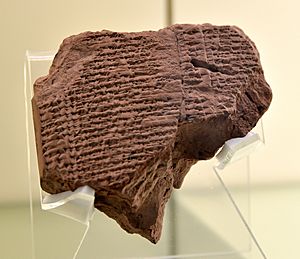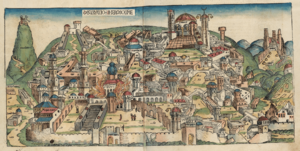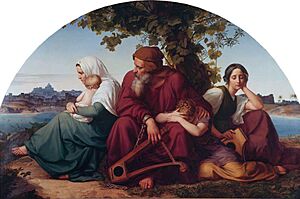Babylonian captivity facts for kids

The Babylonian exile was a time in Jewish history when many people from the ancient Kingdom of Judah were forced to move to Babylonia. This happened because the Neo-Babylonian Empire conquered their land.
The move happened in several stages:
- Around 597 BCE, after the first attack on Jerusalem, about 7,000 people were sent to Mesopotamia.
- More people were forced to leave after Jerusalem and the Temple were destroyed in 587 BCE.
The Bible tells us that after a big battle in 605 BCE, the Babylonian king Nebuchadnezzar II attacked Jerusalem. The king of Judah, Jehoiakim, had to pay tribute (money or goods) to Babylon. Later, Jehoiakim stopped paying. This led to another attack on Jerusalem in 598/597 BCE. King Jehoiakim died, and his son Jeconiah was taken to Babylon with many others.
Later, Nebuchadnezzar II destroyed Jerusalem in 587 BCE, and King Zedekiah was also exiled. Another group was sent away in 582 BCE. The Bible has different numbers and dates for these events.
After the Persian Empire took over Babylon in 539 BCE, the exiled Judeans were allowed to go back to Judah. The biblical Book of Ezra says that building the Second Temple in Jerusalem started around 537 BCE. These events were very important for the history and culture of the Jewish people and greatly shaped Judaism.
Archaeological studies show that while Jerusalem was destroyed, other parts of Judah still had people living in them during the exile. Many Jewish people also chose to stay in Mesopotamia. They formed a large Jewish community there called the golah (meaning "dispersal" or "exile"). Many Jewish communities today, like those from Iraq and Persia, trace their family history back to these exiles. Most of them have now moved to Israel.
Contents
Why Did the Exile Happen?
In the late 600s BCE, the Kingdom of Judah was a small state controlled by the Assyrian Empire. Then, Babylon, which used to be part of Assyria, became very powerful and took over Assyria.
Egypt was worried about Babylon's growing power. Egypt tried to take control of some Assyrian lands. During this time, Josiah, the king of Judah, was killed in a battle with the Egyptians in 609 BCE.
After Babylon defeated Egypt in 605 BCE, King Jehoiakim of Judah started paying tribute to Nebuchadnezzar II of Babylon. Some young nobles from Judah were taken to Babylon.
Over the next few years, Jerusalem's leaders were divided. Some wanted to support Egypt, while others favored Babylon. In 601 BCE, Nebuchadnezzar lost a battle against Egypt. Judah then rebelled against Babylon. This led to a three-month attack on Jerusalem starting in late 598 BCE.
King Jehoiakim died during this attack. His son, Jehoiachin (also called Jeconiah), became king at age eighteen. Jerusalem fell on March 16, 597 BCE. Nebuchadnezzar took valuable items from Jerusalem and its Temple. He also took King Jeconiah, his court, and other important people, including the prophet Ezekiel, to Babylon.
Jehoiakim's uncle, Zedekiah, was made king instead. But the exiles in Babylon still saw Jeconiah as their true ruler.
Even though prophets like Jeremiah warned him, Zedekiah rebelled against Babylon and made a deal with Egypt. Nebuchadnezzar returned, defeated the Egyptians, and attacked Jerusalem again. In 587 BCE, the city was completely destroyed. Nebuchadnezzar tore down the city walls and the Temple.
Zedekiah and his sons were captured. His sons were killed in front of him, and then Zedekiah was blinded and taken to Babylon with many others. Judah became a Babylonian province called Yehud. This ended the independent Kingdom of Judah.
The first governor appointed by Babylon was Gedaliah, a local Judahite. He encouraged many Jews who had fled to nearby countries like Moab and Ammon to come back. He tried to help the country recover. However, a member of the royal family later killed Gedaliah and his Babylonian advisors. This made many people flee to Egypt for safety.
By the end of the 500s BCE, there were large Jewish communities in Babylon and Egypt, as well as those who stayed in Judah. This was the start of the "Jewish Diaspora", where Jewish people lived permanently outside of Judah.
According to the book of Ezra, the Persian king Cyrus the Great ended the exile in 538 BCE, a year after he took over Babylon. The exile ended when people returned under Zerubbabel, a prince from the royal family of David, and Joshua the Priest. They started building the Second Temple between 521 and 516 BCE.
What Evidence Do We Have?
Historians and archaeologists have found evidence that matches the biblical stories of the Babylonian exile.
First Attack (597 BCE)
Nebuchadnezzar's attack on Jerusalem in 597 BCE, his capture of the king, and the city's treasures are confirmed by ancient texts. The Babylonian Chronicles say: "In the seventh year, in the month of Kislev, the king of Akkad gathered his troops, marched to the Hatti-land, and camped against the City of Judah. On the ninth day of the month of Adar, he took the city and captured the king. He chose a new king there and took much tribute back to Babylon."
Also, clay tablets called Jehoiachin's Rations Tablets were found in Babylon. They list food orders for a captive king of Judah, who is believed to be King Jeconiah. One tablet mentions food for "Ya’u-kīnu, king of the land of Yahudu" and his five sons.
Second Attack (589–587 BCE)
Nebuchadnezzar and his army returned in 589 BCE. They caused a lot of destruction throughout Judah. Archaeologists have found clear signs of this in many towns. Clay pieces with writing, called Lachish letters, were found. One letter describes how signal fires from nearby towns were disappearing, meaning those towns were being destroyed. Finds in Jerusalem show that almost the entire city inside the walls was burned to the ground in 587 BCE.
After the Destruction
Before the Babylonian destruction, Judah's population was estimated to be about 75,000 people. If we take the highest biblical number of exiles (20,000), it means about 25% of the people were sent to Babylon. The rest stayed in Judah.
Even though Jerusalem was destroyed and remained mostly in ruins for 150 years, many other towns in Judah continued to be lived in. Archaeologists have found no signs of major disruption in these places.
One archaeologist, Avraham Faust, thinks that between the deportations, executions, famines, and diseases, Judah's population might have dropped to only 10% of what it was before the exile.
Life During Exile
In Mesopotamia, the exiled Judeans were moved to farming communities. One important settlement was Tel Abib near the city of Nippur. Some scholars believe that the exiled Judeans lived a life that was almost as good as what they had in their homeland.
However, there was also hardship. Exiled Jewish leaders were sometimes seen as disloyal and were made to work as farmers or on building projects. They did simple tasks like farming, shepherding, and fishing. This changed when the Persians conquered Babylon.
Ordinary Jewish people in exile missed Judah. They had to stop worshipping at the Temple. Instead, they mostly worshipped in their homes. They kept important religious traditions like circumcision, observing the Sabbath, and reading the Psalms and Law.
Return Under Persian Rule
The Cyrus Cylinder is an ancient clay tablet where King Cyrus declared that he would restore temples and allow exiled people to return home. Many people see this as proof that the biblical stories about Cyrus allowing the Jews to return are true. However, other scholars point out that the cylinder only talks about Babylon and Mesopotamia, not Judah or Jerusalem.
Professor Lester L. Grabbe said that the "decree of Cyrus" about Judah might not be exactly true. But he agreed that there was a general policy of letting exiled people return and rebuild their holy places. He also said that archaeology suggests the return was a slow process over many decades, not a single big event.
Under the Persian Empire, the former Kingdom of Judah became a smaller province called Judah (Yehud Medinata). Its population was much smaller than before, estimated at around 30,000 people in the 400s and 300s BCE.
In 2017, an exhibition in Jerusalem showed over 100 clay tablets. These tablets detailed trade, taxes, and debts of Jewish families who were forced or convinced to move from Jerusalem by King Nebuchadnezzar around 600 BCE. The tablets even included details about one exiled Judean family over four generations, all with Hebrew names.
Most Jews who returned were poor. They saw the exile as either a way to become spiritually better or as a punishment for their sins. Wealthier Jews often stayed in Babylon because there were more economic opportunities there than in Judah.
Writings from the Exile
The time of the exile was very important for Hebrew literature. The Bible describes the exile in several books:
- Book of Jeremiah 39–43 sees it as a lost chance.
- The end of 2 Kings shows it as a temporary end to history.
- 2 Chronicles calls the exile the "Sabbath of the land."
- The first chapters of Ezra tell about the end of the exile.
Other writings from or about the exile include stories in Daniel 1–6, Susanna, Bel and the Dragon, and the books of Tobit and Judith. The Book of Lamentations also came from this time.
The final editing of the Pentateuch (the first five books of the Bible) happened after the exile, during the Persian period.
Why Was the Exile So Important?
In the Hebrew Bible, the Babylonian captivity is shown as a punishment for worshipping idols and not obeying God. It's similar to how the Bible describes the Israelites being slaves in Egypt before they were freed.
The Babylonian exile had a big impact on Judaism and Jewish culture:
- The modern Hebrew alphabet was adopted during this time, replacing an older version.
- This period saw the last great biblical prophecy through Ezekiel. After this, the Torah became the most important text in Jewish life.
- Many scholars believe the Torah was put together during this time and became the main authoritative text for Jews.
- This period helped transform the Jewish people into a group that could survive without a central Temple.
- The exile also marked the beginning of the "Jewish diaspora", meaning large numbers of Jews always lived outside the Land of Israel.
In later Jewish writings, "Babylon" often became a symbol for the Jewish diaspora before the Second Temple was destroyed. After the Temple was destroyed again, "Rome" or "Edom" became the term for the diaspora.
Timeline of the Exile
Here is a simple timeline of the main events, based on historical studies:
| Year | Event |
|---|---|
| 609 BCE | Death of King Josiah. |
| 609–598 BCE | King Jehoiakim rules. He starts paying tribute to Nebuchadnezzar in 605 BCE. The first group of people, possibly including Daniel, is taken to Babylon. |
| 598/7 BCE | King Jehoiachin rules for three months. Jerusalem is attacked and falls. The second group of people is exiled on March 16, 597 BCE. |
| 597 BCE | Zedekiah is made king of Judah by Nebuchadnezzar II. |
| 594 BCE | A plot against Babylon happens. |
| 587 BCE | Jerusalem is attacked and falls again. The Solomon's Temple is destroyed. The third group of people is exiled in July/August 587 BCE. |
| 583 BCE | Gedaliah, the governor chosen by Babylon, is killed. Many Jews flee to Egypt, and a possible fourth group is exiled to Babylon. |
| 562 BCE | Jehoiachin is released after 37 years in a Babylonian prison. He stays in Babylon. |
| 539 BCE | The Persians conquer Babylon in October. |
| 538 BCE | King Cyrus allows Jews to return to Jerusalem. |
| 520–515 BCE | Many Jews return to Yehud under Zerubbabel and Joshua the High Priest. They start building the Second Temple. |
See also
- Assyrian captivity
- Al-Yahudu Tablets, ancient clay tablets about the exiled Jewish community
- Return to Zion, the biblical story of Jews returning to Judah
- Psalm 137, a song expressing sadness of the exiles in Babylon




